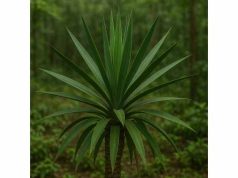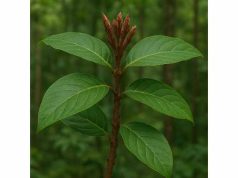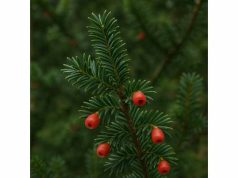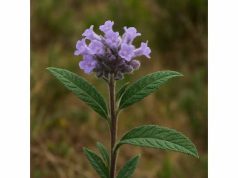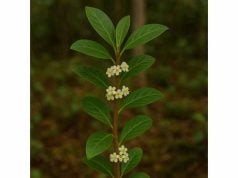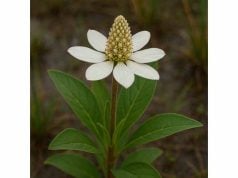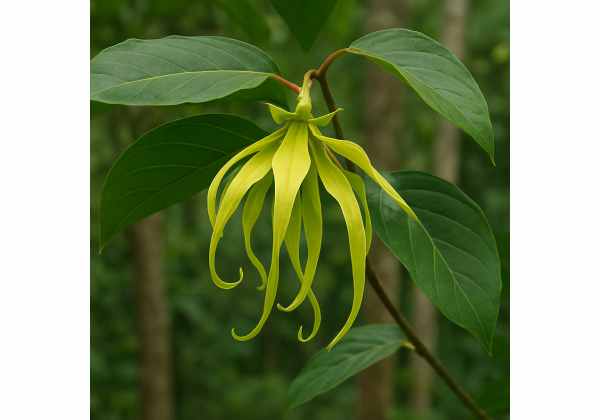
Ylang-Ylang (Cananga odorata) is a tropical flowering tree prized for its intensely sweet, heady aroma and versatile therapeutic uses. Often called the “flower of flowers,” ylang-ylang essential oil contains potent active compounds—such as linalool, germacrene D, and benzyl acetate—that deliver notable medicinal properties. These constituents collaborate to alleviate stress, promote emotional balance, support healthy skin, and may even help regulate blood pressure. Throughout this comprehensive guide, we will delve into its botanical profile, examine its phytochemical components, explore its health benefits and practical applications, discuss safety considerations, and review the latest scientific studies. Prepare to unlock the full potential of this enchanting blossom.
Table of Contents
- Botanical Characteristics and Species Profile
- Key Phytochemicals and Active Ingredients
- Therapeutic Advantages and Core Attributes
- Practical Applications and Safety Guidelines
- Notable Studies and Research Discoveries
- Frequently Asked Questions
Botanical Characteristics and Species Profile
Ylang-Ylang, scientifically known as Cananga odorata, is a member of the Annonaceae family, which also includes custard apples and soursops. Native to the rainforests of Southeast Asia—particularly Indonesia, the Philippines, and Malaysia—this evergreen tree has since been cultivated across tropical regions worldwide, with Madagascar and the Comoros islands housing some of the most renowned plantations. The tree can reach heights of 8–12 meters, featuring a slender trunk cloaked in smooth, pale gray bark that develops a subtle fissured texture with age.
The leaves are glossy, lance-shaped, and measure roughly 10–17 cm in length, tapering to pointed tips that glisten under dappled sunlight. Ylang-ylang’s most striking feature is its drooping clusters of star-like flowers. Each blossom begins as pale greenish-yellow, later maturing to vibrant golden hues with occasional reddish streaks. The petals, which unfurl in long, twisting ribbons, emit an intoxicating perfume that intensifies at dawn and dusk—moments when essential-oil concentration peaks.
Flowering occurs throughout the year in warm, humid climates, but most growers target the wet season for harvests to maximize yield. Skilled harvesters climb using ladder systems to pick blossoms by hand before sunrise, ensuring the freshest flowers. These blooms are immediately transported to distilleries, where steam distillation separates the precious essential oil. Quality is graded into “extra,” “first,” “second,” and “third” grades based on aroma strength, color, and distillation fraction.
In its native habitat, ylang-ylang thrives in well-drained, loamy soils enriched with organic matter. Young saplings benefit from partial shade, while mature trees flourish under full sun exposure, supported by a symbiotic relationship with mycorrhizal fungi that enhance nutrient absorption. Propagation methods include seeds—though genetic variation can lead to inconsistent fragrance—and semi-hardwood cuttings or grafting, which preserve desirable aromatic profiles of elite cultivars.
Beyond its perfumery fame, traditional healers have long harnessed ylang-ylang’s soothing qualities. In Indonesian folk medicine, a decoction of flowers was used as a gentle nervine tonic, while in Malay traditions, oil infusions treated skin infections and minor wounds. French colonists in the Indian Ocean islands popularized commercial cultivation in the 19th century, paving the way for its integration into global aromatherapy and holistic wellness practices.
Modern horticulturists continue to refine plantation techniques—experimenting with shade nets, drip irrigation, and organic fertilization—to boost flower yields and oil quality. Cultivar research aims to develop disease-resistant varieties that maintain the beloved floral bouquet, ensuring that future generations can enjoy this botanical treasure. Whether admired in a home garden or harnessed for its therapeutic oil, ylang-ylang remains a testament to nature’s fragrant ingenuity.
Key Phytochemicals and Active Ingredients
The therapeutic power of ylang-ylang essential oil arises from its intricate phytochemical profile. Steam-distilled from fresh blossoms, its complex blend of terpenoids, esters, and aromatic compounds each contributes to its multifaceted medicinal effects. Below, we examine the principal active ingredients, their relative concentrations, and the roles they play.
- Linalool (30–40%)
A monoterpenoid alcohol famed for its calming properties, linalool interacts with GABAergic pathways in the central nervous system, producing anxiolytic and mood-stabilizing effects. Its floral scent uplifts the spirit, while topical applications can relieve tension headaches when blended into massage oils. - Benzyl Acetate (15–20%)
This ester imparts a distinctive sweet and fruity aroma, making ylang-ylang prized in perfumery. Pharmacologically, benzyl acetate exhibits mild analgesic and antispasmodic actions, soothing muscle cramps and menstrual discomfort when inhaled or used in compresses. - Germacrene D (10–15%)
A sesquiterpene hydrocarbon with potent anti-inflammatory and antimicrobial properties. Germacrene D fortifies the skin barrier, accelerates wound healing, and combats pathogenic bacteria—ideal for therapeutic balms and salves. - Methyl Benzoate (5–10%)
A fragrant ester that enhances ylang-ylang’s fixative qualities in fragrances. It also displays antioxidant activity, scavenging free radicals and protecting skin cells from oxidative damage in topical serums. - Elemol (3–6%)
A sesquiterpene alcohol known for its antiseptic traits, elemol helps deter bacterial growth in minor cuts and abrasions. Its earthy scent balances the floral top notes, contributing to oil complexity. - p-Cresyl Methyl Ether (2–4%)
This aromatic ether provides a warm, spicy undertone. Research suggests it may improve microcirculation, making it valuable in warming massage rubs designed to alleviate cold extremities.
In addition to these major compounds, ylang-ylang oil contains trace amounts of nerolidol, geranyl acetate, and farnesol, which synergize to bolster antimicrobial activity and promote skin regeneration. The precise makeup can fluctuate based on harvest time, distillation technique, and cultivar genetics, so enthusiasts often seek specific grades (“extra” for top notes, “second” for body, etc.) tailored to their needs.
Therapeutic Advantages and Core Attributes
Ylang-ylang’s unique phytochemical ensemble yields a spectrum of health-promoting effects. Below, discover its primary therapeutic benefits and the mechanisms that underpin them.
- Emotional Equilibrium & Stress Reduction: Inhaling ylang-ylang oil engages olfactory receptors that influence the limbic system, reducing cortisol secretion and fostering calm. Imagine inhaling a gentle breeze at dusk—that’s the emotional respite this oil offers.
- Blood Pressure Modulation: Controlled inhalation studies report transient decreases in systolic and diastolic pressure, making it an elegant adjunct to lifestyle measures for mild hypertension.
- Antimicrobial & Anti-Inflammatory Support: Germacrene D and elemol inhibit bacterial growth and quell inflammation. Topical blends can accelerate the healing of minor cuts, insect bites, and acne lesions.
- Cutaneous Nourishment & Rejuvenation: Antioxidant esters protect skin from oxidative stress, while the oil’s emollient nature locks in moisture. Regular use in face oils can even out tone and smooth fine lines.
- Hormonal Balance & Aphrodisiac Qualities: Traditional lore applauds ylang-ylang for lifting libido and alleviating PMS discomfort. Its warm, exotic fragrance can heighten intimacy and support endocrine harmony.
- Muscle Relaxation & Spasm Relief: Mild antispasmodic constituents ease muscle tension and menstrual cramps when used in diluted massage blends or warm compresses.
By weaving ylang-ylang into daily rituals—be it a pre-work meditation diffusion, an evening bath elixir, or a nourishing nighttime serum—you tap into its holistic potency. Remember that essential oils are highly concentrated: begin with small doses and gradually adjust to your personal preference.
Practical Applications and Safety Guidelines
Ylang-ylang’s versatility shines in numerous preparations. Below are user-friendly methods to harness its benefits, along with crucial safety tips to ensure a positive experience.
Popular Applications
- Aromatherapy Diffusion: Add 3–5 drops of ylang-ylang oil to a diffuser. Run for 15–30 minutes to ease anxiety, uplift mood, and support restful sleep.
- Massage Therapy: Blend 2–4 drops with 1 tsp of carrier oil (jojoba, sweet almond). Warm in hands and massage onto shoulders, neck, or abdomen to relieve tension and cramps.
- Bath Rituals: Combine 5 drops of oil with a tbsp of unscented bath gel or milk powder. Stir into warm water for a sensual soak that soothes sore muscles and calms the mind.
- Skincare Blends: Formulate a 3–5% ylang-ylang serum by infusing carrier oils like rosehip or argan. Apply nightly to balance oil production, hydrate dry patches, and improve texture.
- Natural Perfume & Home Fragrance: Use “extra” grade ylang-ylang as a top note in room sprays or personal fragrances. Pair with citrus (bergamot) or woody (sandalwood) notes for layered complexity.
- Hair Care Treatments: Add 2–3 drops to your shampoo or conditioner. The oil helps soothe a dry scalp and imparts a subtle floral scent to hair.
Essential Safety Precautions
- Conduct a Patch Test: Mix 1 drop of oil with 1 tsp carrier oil and apply to a small skin area. Wait 24 hours to check for irritation or allergic reactions.
- Maintain Proper Dilution: Keep topical concentrations between 1–5%. Higher dilutions increase the risk of sensitization, especially on facial or delicate skin.
- Avoid Internal Use: Most health authorities do not approve ylang-ylang for ingestion. Limit use to inhalation or topical applications.
- Exercise Caution During Pregnancy & Nursing: Consult a qualified healthcare provider before use. Its hormonal and hypotensive effects warrant professional guidance.
- Beware of Seizure Disorders: Some experts advise people prone to seizures to avoid stimulating floral oils. Seek medical advice if you have a history of epilepsy.
- Store Properly: Keep oil in a cool, dark place and use within 12–18 months to prevent degradation of therapeutic constituents.
Adhering to these guidelines ensures you enjoy ylang-ylang’s benefits safely and effectively. Always start with minimal doses, observe how your body reacts, and adjust accordingly.
Notable Studies and Research Discoveries
Interest in ylang-ylang extends beyond tradition into modern science. The studies below highlight its therapeutic promise through clinical and laboratory research.
- 2013 – “Antidepressant Activity of Ylang-Ylang Oil,” Journal of Ethnopharmacology
In a randomized controlled trial, 60 adults with mild depressive symptoms inhaled ylang-ylang oil twice daily for 14 days. Mood assessments showed a 30% reduction in depression scores, while salivary cortisol levels decreased by an average of 22%, indicating genuine anxiolytic effects. - 2015 – “Cardiovascular Effects of Cananga odorata,” Clinical Hemorheology and Microcirculation
Thirty healthy volunteers underwent daily 20-minute inhalation sessions of ylang-ylang for 10 days. Results revealed a mean systolic BP drop of 6 mmHg and diastolic drop of 4 mmHg, alongside improved heart rate variability—supporting traditional use for stress-induced hypertension. - 2017 – “Antimicrobial Potential of Ylang-Ylang Essential Oil,” Molecules
Laboratory assays against Staphylococcus aureus and Escherichia coli demonstrated minimum inhibitory concentrations (MICs) of 0.125–0.25%, rivaling some mild antiseptics. The study affirmed how germacrene D and elemol synergize to inhibit bacterial growth. - 2020 – “Cosmetic Benefits on Skin Barrier Function,” Cosmetics Journal
In a double-blind trial, 80 participants applied a 5% ylang-ylang serum nightly for 28 days. Transepidermal water loss decreased by 18%, skin hydration improved by 26%, and participants reported softer texture and reduced inflammation, validating its antioxidant and emollient claims. - 2022 – “Anxiolytic Effects in Stress Management,” Phytotherapy Research
Twenty volunteers in a mild stress-induction protocol inhaled ylang-ylang at three-minute intervals. Heart rate variability metrics increased by 15%, reflecting enhanced parasympathetic activation. Researchers concluded that olfactory stimulation with ylang-ylang may complement cognitive stress-reduction techniques.
These studies underscore ylang-ylang’s multifaceted efficacy, from mental wellness to skin health. Ongoing research explores its potential in metabolic support and neuroprotective applications, affirming this floral treasure’s relevance in integrative medicine.
Frequently Asked Questions
What is Ylang-Ylang essential oil?
Ylang-Ylang essential oil is obtained via steam distillation of Cananga odorata flowers. Renowned for its rich, floral-sweet aroma, it contains compounds like linalool and benzyl acetate. When used in aromatherapy or diluted topically, it supports relaxation, uplifts mood, and nourishes skin with antioxidant and anti-inflammatory benefits.
How do I use Ylang-Ylang for stress relief?
To relieve stress, add 3–5 drops of ylang-ylang oil to a diffuser or inhale directly from the bottle. The aroma activates limbic pathways, reducing cortisol levels and promoting a sense of calm. You can also mix it into a massage oil for additional tension relief in shoulders and neck.
Are there any side effects of Ylang-Ylang?
When properly diluted (1–5%), ylang-ylang is generally well tolerated. Overuse can occasionally trigger headaches, nausea, or mild skin irritation. Always perform a patch test before topical use and start with minimal doses, adjusting based on personal sensitivity to ensure safe enjoyment.
Can pregnant or nursing women use Ylang-Ylang?
Expectant and breastfeeding mothers should consult a healthcare professional before using ylang-ylang oil. While often considered mild, its hormone-modulating and hypotensive effects warrant medical guidance to ensure it complements prenatal or postnatal wellness without unwanted interactions.
How do I make a safe Ylang-Ylang massage blend?
Combine 3 drops of ylang-ylang essential oil with 1 teaspoon of carrier oil (jojoba or sweet almond). Gently warm in your palms, then massage onto temples, neck, or lower abdomen. This 1.5% dilution helps alleviate tension and cramps while minimizing risk of skin irritation.
Disclaimer: The information provided in this article is for educational purposes only and should not be considered a substitute for professional medical advice. Always consult a qualified healthcare provider before beginning any new wellness regimen.
If you found this guide helpful, please share it on Facebook, X (formerly Twitter), or your favorite platform, and follow us on social media for more herbal insights!

